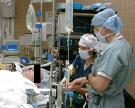Patients receiving anesthesia in remote locations tend to be older and sicker than those in the Main OR. In addition, they tend to receive MAC anesthesia more frequently. Below is a case scenario. Read the entire article from the ASPF newsletter and add your comments.
A 75-year-old, 100-kg, ASA 2 man was scheduled for endoscopic retrograde cholangiopancreatography (ERCP) under monitored anesthesia care (MAC). Monitors, including pulse oximetry, blood pressure, and ECG, were placed and the patient was turned prone for the procedure. He was given midazolam 2 mg and fentanyl 50 mcg IV, and he remained anxious. Additional midazolam 2 mg and fentanyl 150 mcg IV were given, but the patient could not tolerate insertion of the endoscope. Propofol 20 mg IV, followed by an infusion of 50-70 mcg/kg/min, was administered, and the procedure was begun with O2 saturations 88-92% on 4 L/min O2 by nasal prongs. After 20 minutes, the O2 saturation decreased to 70%, and the patient became severely bradycardic, and was treated with atropine 1 mg. Attempts at bag-mask ventilation and placement of a laryngeal mask airway failed. Blood pressure was not obtainable and the procedure was aborted. It took 2-3 minutes to push aside the heavy endoscopy equipment, move in a gurney, and turn the patient supine to begin CPR. Although the patient was resuscitated after 10 minutes of CPR, he sustained severe anoxic brain damage, and life support was eventually discontinued.


name: Thoughtful considerAtion
comments: Remote area Anesthesia
As with any other area that we are asked to render our services, the depArtment need
to take a hard look at places we are asked to. There is a need to look into all
components that would generate a safer practice. This includes the delivery and
efficacy of all types of emergent situations, workspace, ergonomic placement of
anesthesia machine, monitors, emergency equipment, drugs, and the like. There is a
need for risk and outcome analysis, notwithstanding the cost.
The situation that was posted is an identifiable one as we all can very much relate
to this. The challenge is mainly addressed to the system.
On the clinical level, There would be questions as to BMI, ASa?, medical history? ,
and overall preop evaluation? The patient could very well have a vasovagal response
to the insertion of the scope and may could have exacerbated the parasympathetic
responses leading to the deterioration of the systems. This scenario can happen as
with any other case. Now, would it be safer if it was done with a GEta?
Could this deterioration be averted if attention and rescue was done in the nick of
time? Could it be far safer if the anesthesia providers PREPARED and expected the
worst?
Superior thinking desmonrtated above. Thanks!
Terrific work! This is the type of information that should be shared around the web. Shame on the search engines for not positioning this post higher!
My website is on Depression symptoms.
Woot, I will creatinly put this to good use!
Essays like this are so imporntat to broadening people’s horizons.
Hahahaha. I’m not too brhgit today. Great post!
would love to forever get updated outstanding web blog ! .
Love your blog!
My family and I are truly thankful on your generosity and for presenting me the potential to pursue my chosen profession path. Many thanks for the important information I acquired from your website.
Remote locations present a challenge. Your resources are limited but you are expected to maintain the same standards. It can be tough and I’m glad that people are writing about it.